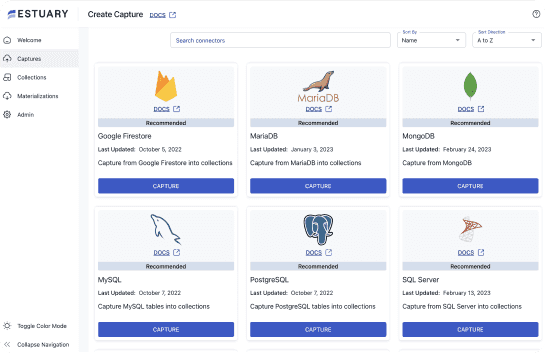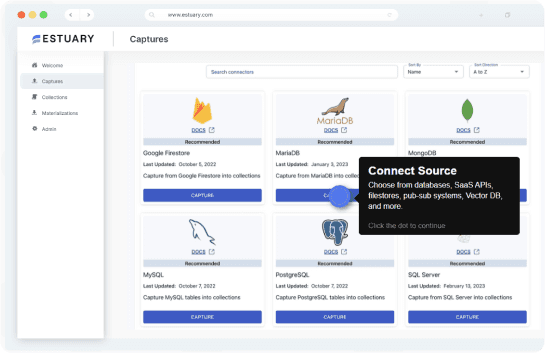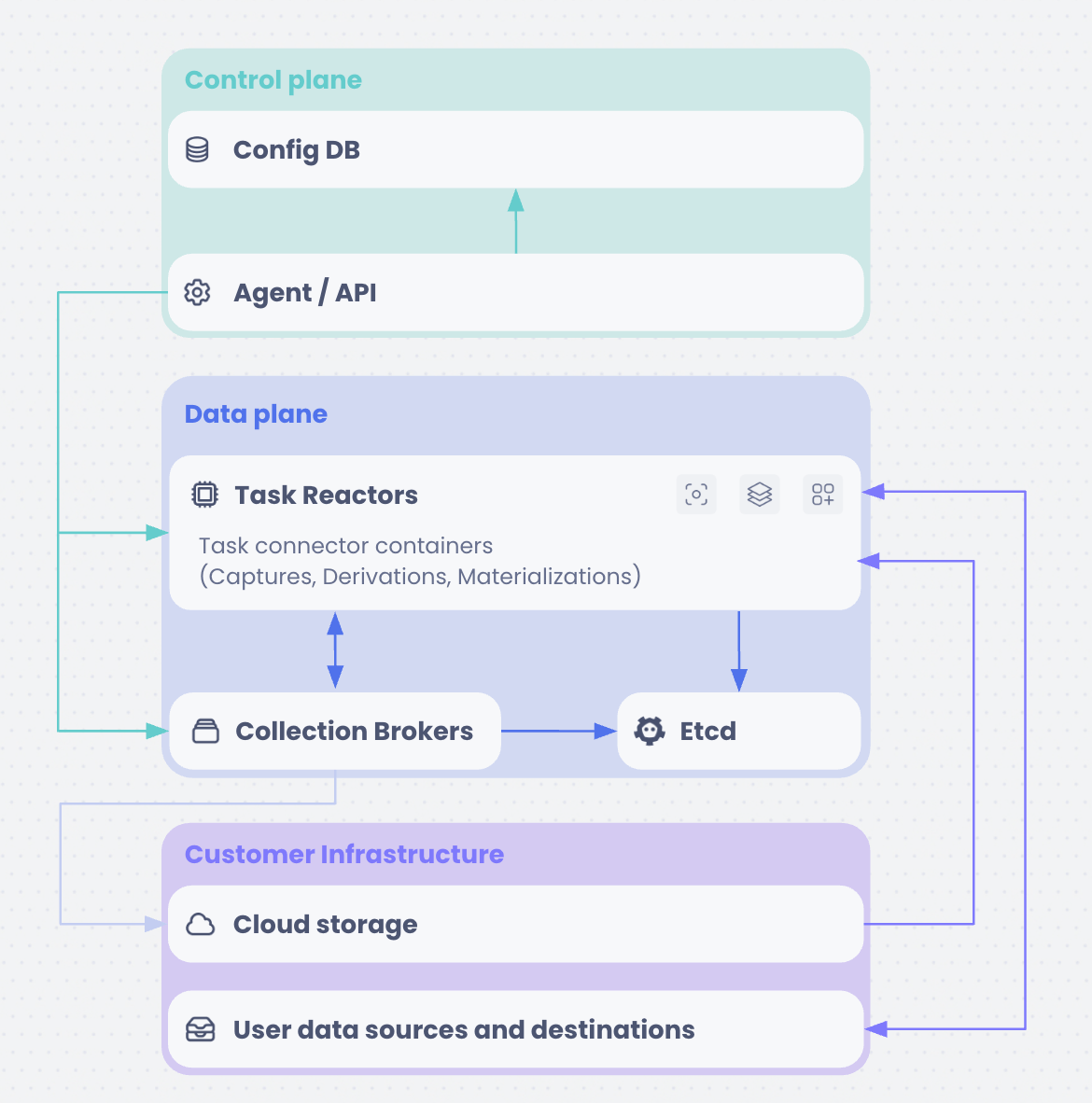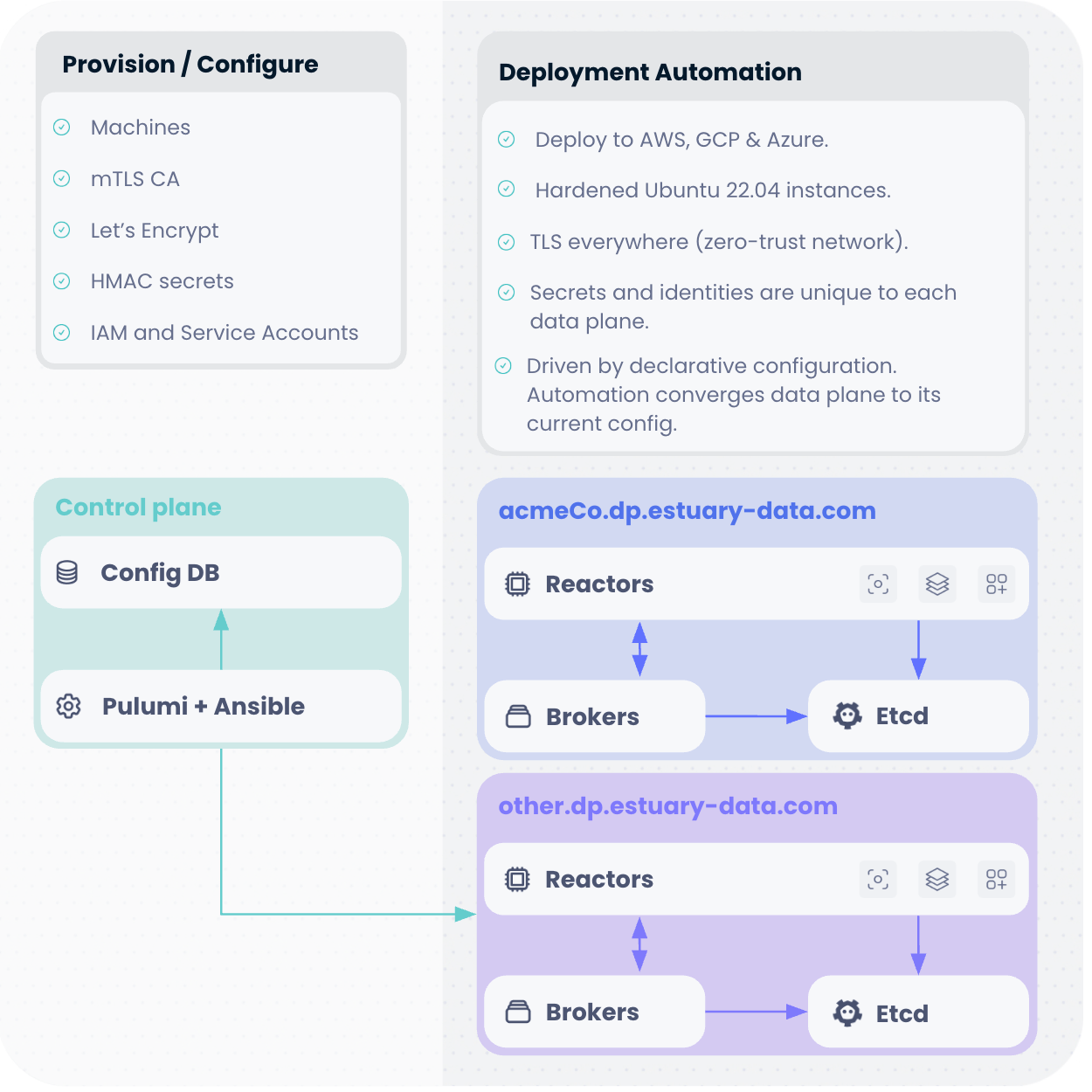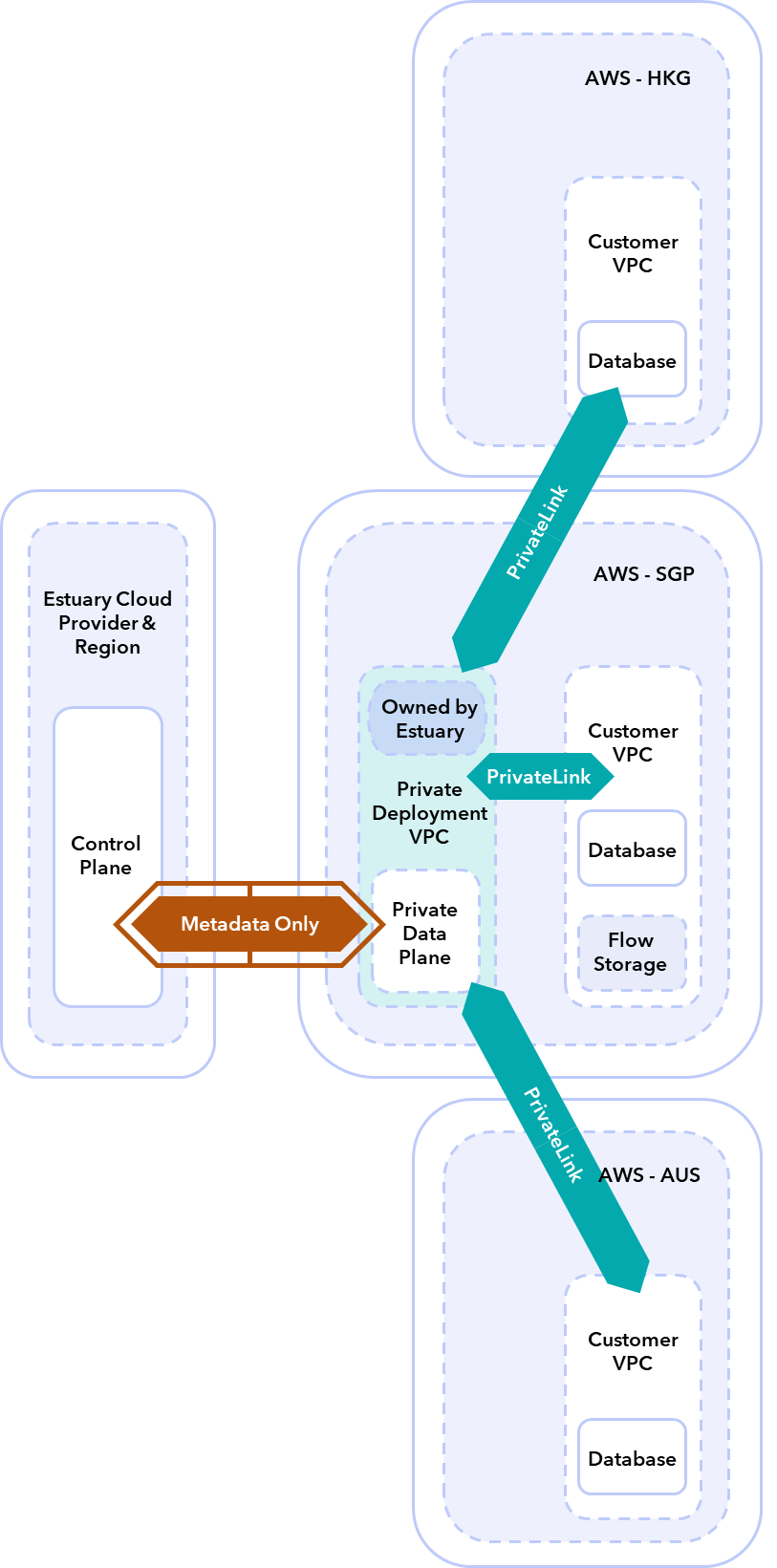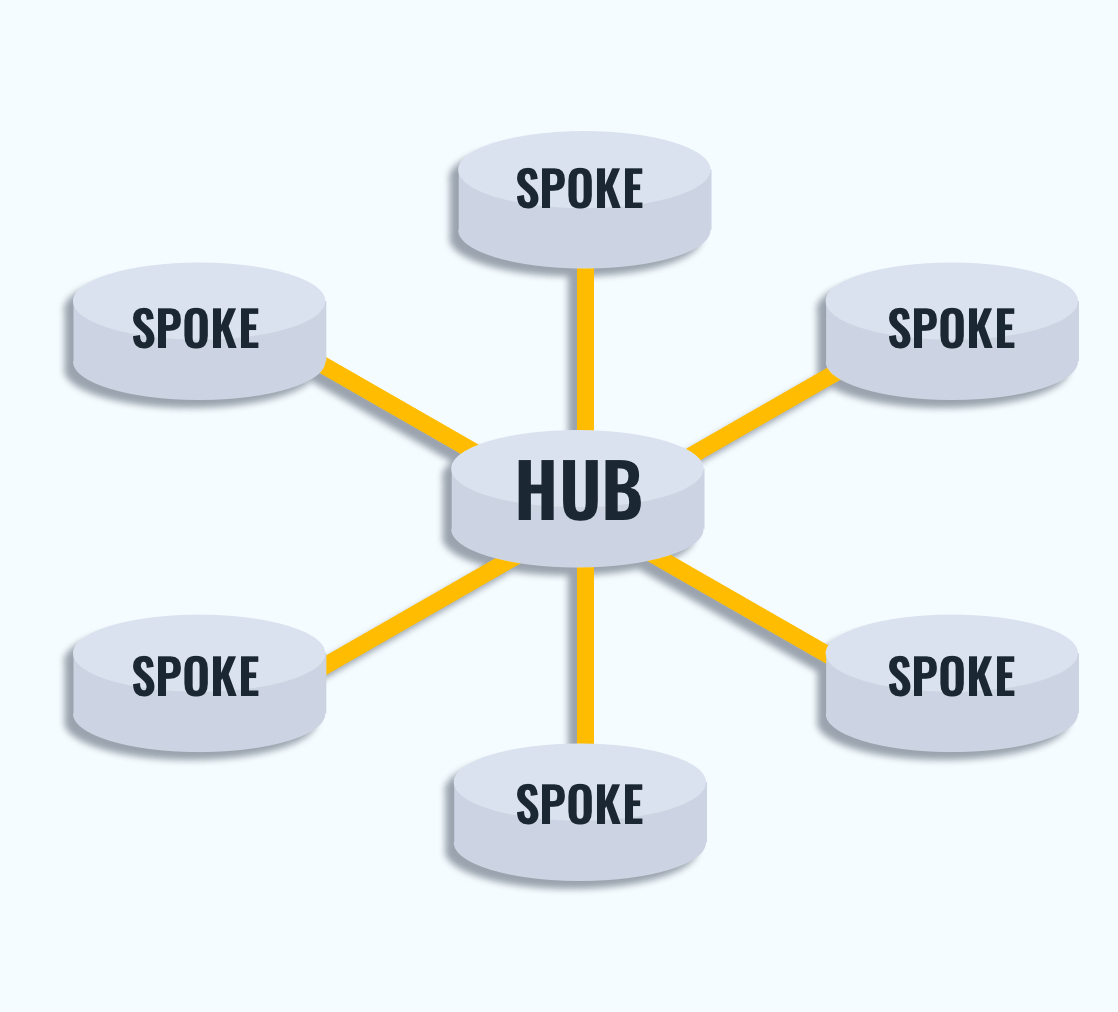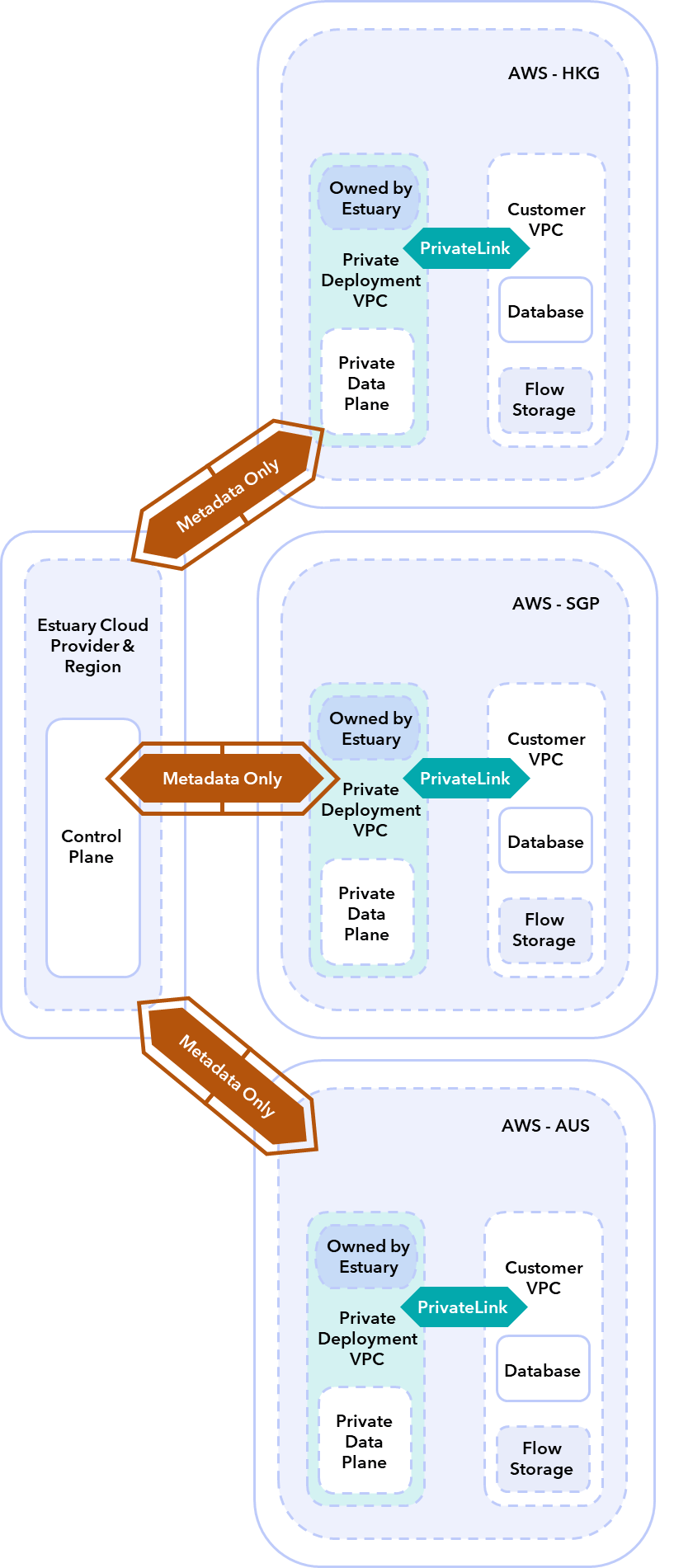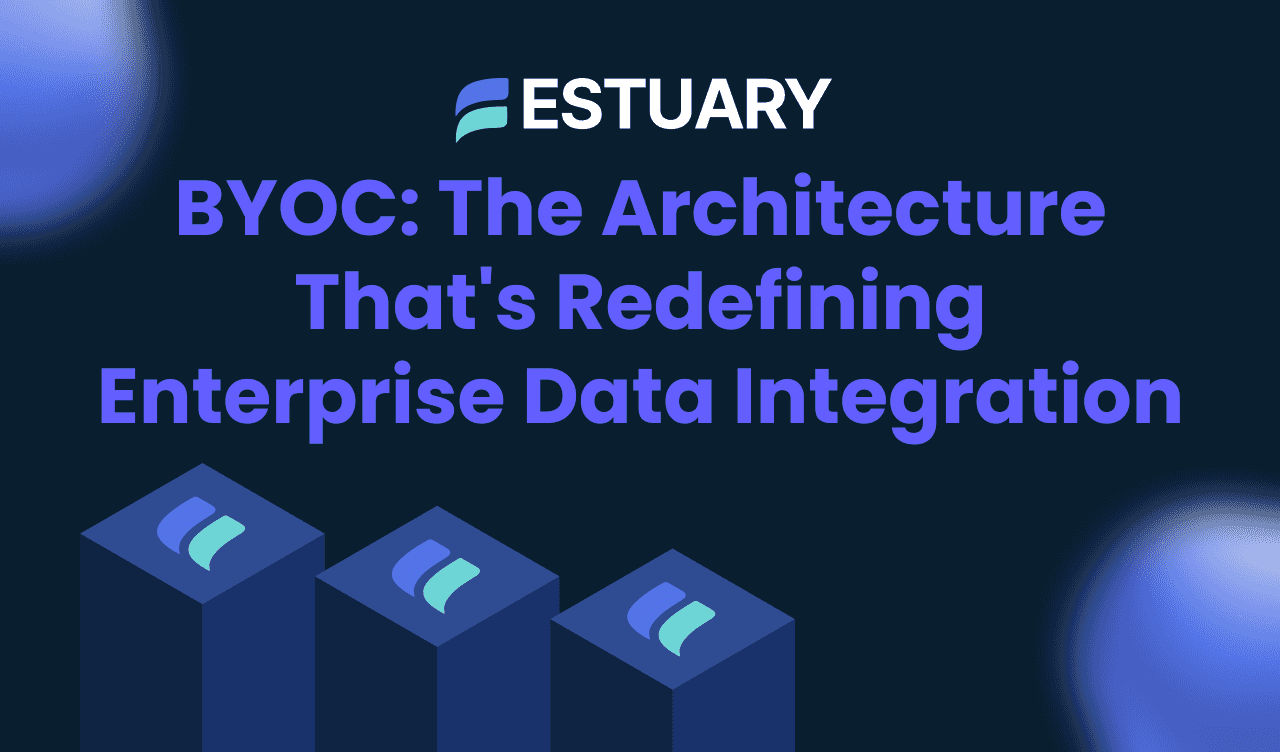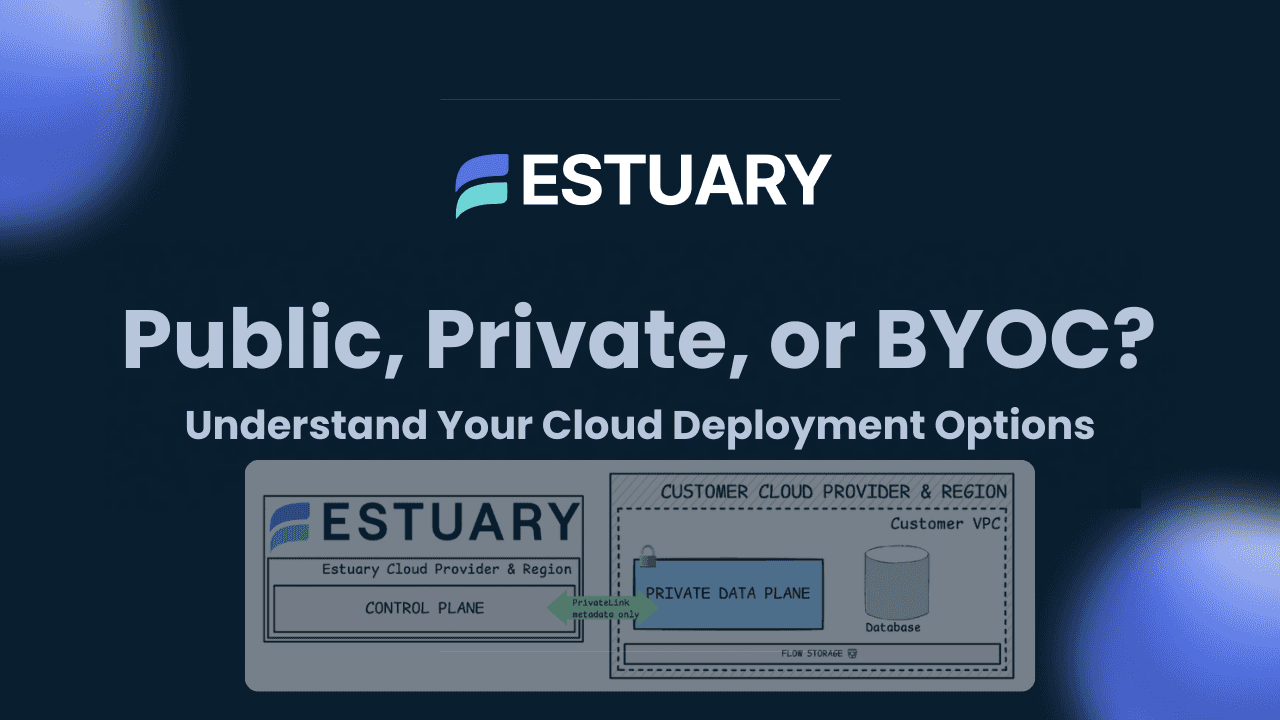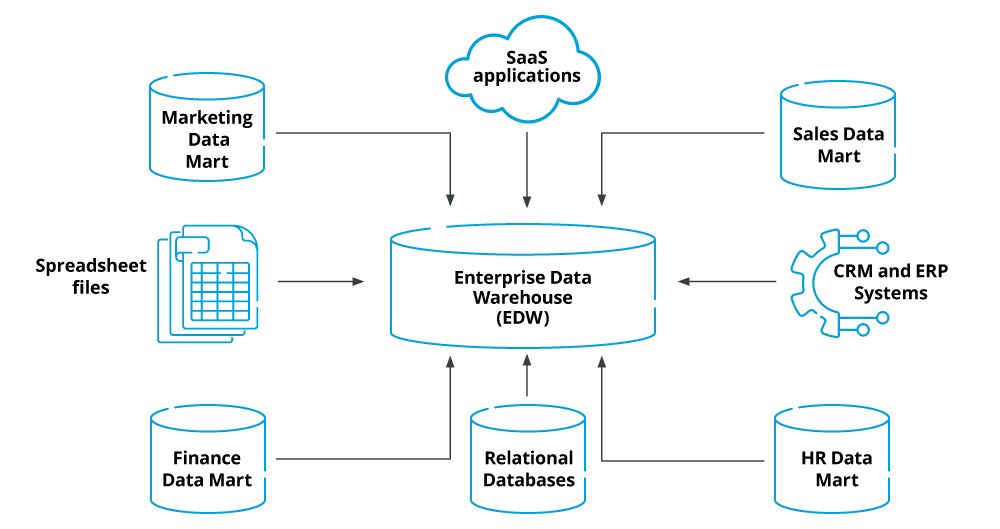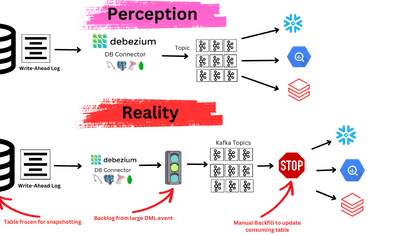
Decoupled Control Plane, Flexible Data Plane: How Estuary Unlocks Powerful Hybrid Deployment Patterns
Discover how Estuary’s decoupled control and data plane architecture enables flexible, cost-efficient, and compliant hybrid cloud deployments — from centralized CDC fan-out to regionally isolated real-time processing.
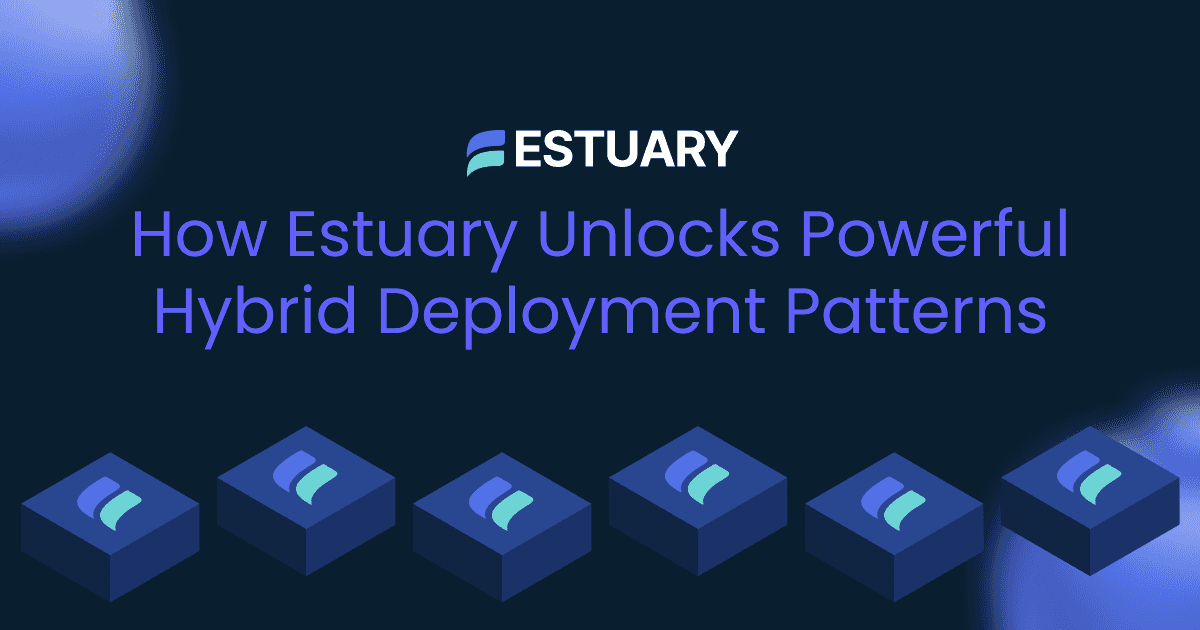
Introduction
Modern enterprises face increasing complexity when building data architectures that span multiple regions, cloud providers, and compliance jurisdictions. Traditional data pipeline tools force organizations into rigid deployment models that create operational overhead, inflate costs, and limit architectural flexibility. These constraints become particularly problematic when dealing with real-time data movement across geographically distributed systems.
Estuary addresses these challenges through a fundamental architectural decision: complete decoupling of the control plane from the data plane. This separation enables organizations to deploy two distinct topology patterns that optimize for different technical and business requirements. The first topology centralizes data processing in a single region while maintaining secure connectivity to distributed data sources. The second topology distributes data processing regionally while maintaining centralized governance and orchestration.
In this article, we explore two powerful hybrid deployment patterns enabled by Estuary’s architecture:
- A hub-and-spoke model with a single centralized data plane serving multiple regions.
- A multi-region data plane topology for regionally isolated processing with centralized orchestration.
We will explore how this architectural approach differentiates Estuary from traditional data integration platforms and enables deployment flexibility that few competitors can match.
Control Plane vs Data Plane: Roles and Responsibilities in Estuary's Architecture
The control plane operates as a centralized orchestration layer that manages configuration, metadata, and user interactions. It hosts the web interface, API endpoints, and catalog services that define data flows, transformations, and materializations. The control plane maintains no direct contact with customer data and focuses exclusively on coordination and governance functions.
The data plane executes the actual data movement operations. It processes captures from source systems, applies transformations, and materializes results to destination systems. Data planes can be deployed in customer VPCs or Estuary-managed environments, depending on security and compliance requirements. Each data plane operates independently but receives orchestration instructions from the central control plane.
This separation creates distinct failure domains and scaling characteristics. Control plane operations scale based on the number of concurrent users, API calls, and configuration changes. Data plane operations scale based on data volume, transformation complexity, and destination system capacity. The decoupled architecture allows each component to scale independently without affecting the other.
Why Decoupling Matters
Independent scaling represents the most immediate benefit of architectural decoupling. Organizations can provision data plane resources based on actual data processing requirements while maintaining a lightweight control plane footprint. This prevents over-provisioning scenarios where control plane resources sit idle during data processing peaks or where data plane resources consume unnecessary capacity during configuration-heavy periods.
Data isolation provides critical security benefits. Customer data never transits through the control plane, reducing attack surface and simplifying compliance auditing. Data plane deployments can be isolated within customer VPCs, ensuring that sensitive information remains within customer-controlled network boundaries. This isolation enables organizations to implement zero-trust network architectures where data processing occurs in verified, controlled environments.
Topological flexibility emerges as the most strategically valuable benefit. Organizations can deploy data planes in configurations that optimize for cost, latency, compliance, or operational complexity. The control plane remains agnostic to data plane topology, enabling architectural evolution without requiring platform migration or configuration rebuilding.
Topology 1: Single Data Plane, Multi-Region (Hub & Spoke Model)
How It Works
The single data plane topology centralizes all data processing in one geographic region while maintaining secure connectivity to distributed data sources. A typical implementation deploys the data plane in a central region such as Singapore, with AWS PrivateLink connections extending to customer VPCs in Hong Kong, Australia, and other regions.
Customer data sources connect to the central data plane through these PrivateLink tunnels, ensuring that data transmission occurs over AWS backbone infrastructure rather than the public internet. The data plane processes all capture, transformation, and materialization operations from the central location, storing intermediate results in a single S3 bucket or equivalent cloud storage service.
This topology creates a hub-and-spoke pattern where the central data plane serves as the processing hub while customer environments act as spokes providing data sources and destinations. The control plane orchestrates this entire topology from a separate location, maintaining complete visibility and control over the distributed data flows.
Advantages
Cost Efficiency
- Only one data plane environment to pay for, regardless of region count.
- Additional regions require only PrivateLink connections, not new data planes.
- Scales economically as geographic footprint expands.
Operational Simplicity
- Centralized monitoring and maintenance of a single data plane.
- Simplified scaling and resource allocation.
- Uniform application of security policies, access controls, and compliance.
High Reuse Efficiency
- Capture data once and deliver to multiple destinations across regions.
- Reduces load on source systems in CDC scenarios.
- Avoids duplicating capture logic per region.
Competitive Differentiation
- Rare among data integration platforms; few support this topology.
- Estuary offers seamless cross-region flow without infrastructure duplication.
Considerations
Cross-region PrivateLink support creates a technical dependency on cloud provider capabilities. AWS and Azure offer robust cross-region PrivateLink functionality, but other cloud providers may have limitations. Organizations using Google Cloud Platform or multi-cloud environments may need to implement additional networking solutions to achieve equivalent connectivity.
Data sovereignty and compliance requirements may restrict cross-region data flows. Organizations operating in jurisdictions with strict data residency laws cannot use single data plane topologies if the processing region differs from the data origin region. These constraints particularly affect organizations in the European Union under GDPR or companies operating in China under local data protection regulations.
Topology 2: Multiple Data Planes, Multi-Region
How It Works
The multiple data plane topology distributes processing capacity across regions while maintaining centralized orchestration through a single control plane. Each region hosts its own data plane deployment within customer VPCs or Estuary-managed environments. Data processing occurs locally within each region, with results stored in regional storage systems.
The control plane coordinates all regional data planes through secure API connections, ensuring consistent configuration and monitoring across the distributed deployment. Each data plane operates independently but reports status and metrics to the central control plane for unified visibility and management.
This topology creates a distributed processing model where data remains within regional boundaries while maintaining centralized governance. Organizations can implement region-specific policies, compliance controls, and operational procedures while benefiting from unified monitoring and configuration management.
Advantages
Compliance-Friendly
- Ensures data processing stays within required geographic boundaries.
- Supports local security, encryption, and access policies to meet regional regulations.
Low-Latency Processing
- Processes data near the source, reducing network delays.
- Ideal for real-time analytics and operational workflows.
Cloud-Agnostic Scale-Out
- Deploy data planes across different cloud providers per region.
- Avoids vendor lock-in and optimizes for local pricing and capabilities.
Considerations
Higher cost reflects the reality of operating multiple independent data plane environments. Each regional deployment requires dedicated compute, storage, and networking resources. Organizations must evaluate whether the benefits of regional processing justify the additional infrastructure costs.
Operational overhead increases with multiple data planes despite centralized control plane management. Each regional deployment requires monitoring, maintenance, and scaling decisions. While the control plane provides unified visibility, regional data planes may require region-specific operational procedures and expertise.
Single vs Multiple Data Planes: How to Choose the Right Deployment Model
Choosing between a single data plane and multiple data planes depends on your organization’s technical constraints, compliance mandates, and operational priorities. Estuary’s decoupled architecture supports both models, but each shines in different scenarios.
Use Case | Single Data Plane | Multiple Data Planes |
| Cost-sensitive, global capture | ✅ | 🚫 |
| Data sovereignty required | 🚫 | ✅ |
| Enterprise CDC “Capture Once, Deliver Many” | ✅ | 🚫 |
| Low-latency regional processing | 🚫 | ✅ |
| Cloud providers with cross-region PrivateLink (AWS/Azure) | ✅ | ✅ |
Cost-sensitive organizations with global data capture requirements benefit most from single data plane deployments. The centralized processing model minimizes infrastructure costs while supporting worldwide data collection and distribution. This approach works particularly well for organizations expanding internationally where operational simplicity outweighs regional processing benefits.
Data sovereignty requirements mandate multiple data plane deployments when legal or regulatory constraints prevent cross-region data flows. Organizations operating in multiple jurisdictions with strict data residency laws must deploy regional data planes to ensure compliance. The additional cost and complexity represent necessary investments to meet legal requirements.
Enterprise change data capture scenarios favor single data plane deployments for their efficiency benefits. Organizations implementing "capture once, deliver many" patterns can minimize source system load while supporting multiple downstream consumers. This approach scales efficiently as organizations add new destinations or expand geographic coverage.
Low-latency regional processing requirements necessitate multiple data plane deployments. Organizations with time-sensitive data flows that cannot tolerate cross-region network latency must deploy processing capacity close to data sources. The performance benefits justify the additional infrastructure and operational costs.
Cloud provider capabilities influence topology selection. Organizations using AWS or Azure can leverage cross-region PrivateLink capabilities to implement single data plane topologies effectively. Organizations using other cloud providers or hybrid environments may require multiple data plane deployments to achieve equivalent security and performance characteristics.
Conclusion
Estuary's decoupled control plane and data plane architecture provides organizations with deployment flexibility that addresses diverse technical and compliance requirements. The architectural separation enables two distinct topology patterns that optimize for different organizational priorities and constraints.
Organizations can choose single data plane deployments for cost efficiency and operational simplicity, or multiple data plane deployments for compliance and performance optimization. The control plane maintains centralized governance and orchestration regardless of the chosen data plane topology, ensuring consistent management and monitoring capabilities.
This flexibility proves particularly valuable for organizations operating in dynamic environments where requirements evolve over time. The architectural foundation supports topology changes without requiring platform migration or configuration rebuilding, enabling organizations to adapt their data infrastructure as business needs change.
FAQs
When should I use a single data plane vs. multiple data planes?
Does Estuary support hybrid and multi-cloud deployments?

About the author
Dani is a data professional with a rich background in data engineering and real-time data platforms. At Estuary, Daniel focuses on promoting cutting-edge streaming solutions, helping to bridge the gap between technical innovation and developer adoption. With deep expertise in cloud-native and streaming technologies, Dani has successfully supported startups and enterprises in building robust data solutions.

